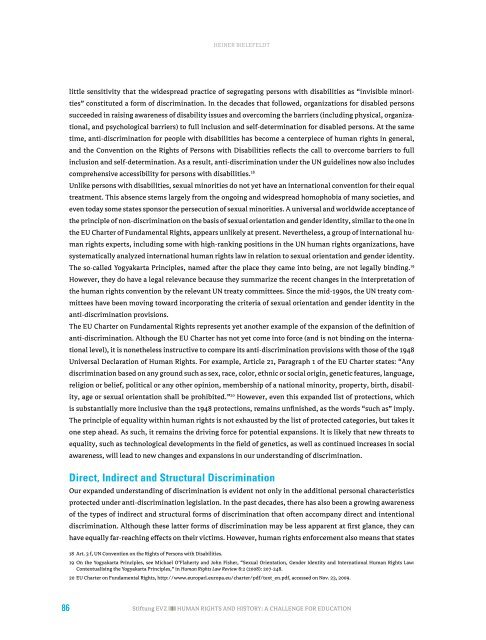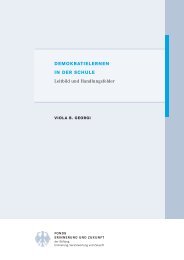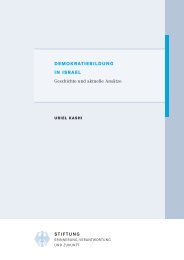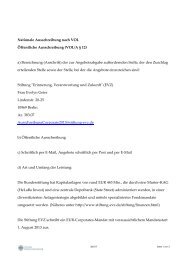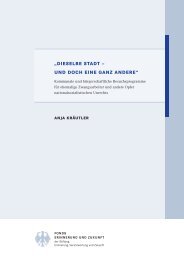chapter 2 - Stiftung "Erinnerung, Verantwortung und Zukunft"
chapter 2 - Stiftung "Erinnerung, Verantwortung und Zukunft"
chapter 2 - Stiftung "Erinnerung, Verantwortung und Zukunft"
You also want an ePaper? Increase the reach of your titles
YUMPU automatically turns print PDFs into web optimized ePapers that Google loves.
Heiner Bielefeldt<br />
little sensitivity that the widespread practice of segregating persons with disabilities as “invisible minorities”<br />
constituted a form of discrimination. In the decades that followed, organizations for disabled persons<br />
succeeded in raising awareness of disability issues and overcoming the barriers (including physical, organizational,<br />
and psychological barriers) to full inclusion and self-determination for disabled persons. At the same<br />
time, anti-discrimination for people with disabilities has become a centerpiece of human rights in general,<br />
and the Convention on the Rights of Persons with Disabilities reflects the call to overcome barriers to full<br />
inclusion and self-determination. As a result, anti-discrimination <strong>und</strong>er the UN guidelines now also includes<br />
comprehensive accessibility for persons with disabilities. 18<br />
Unlike persons with disabilities, sexual minorities do not yet have an international convention for their equal<br />
treatment. This absence stems largely from the ongoing and widespread homophobia of many societies, and<br />
even today some states sponsor the persecution of sexual minorities. A universal and worldwide acceptance of<br />
the principle of non-discrimination on the basis of sexual orientation and gender identity, similar to the one in<br />
the EU Charter of F<strong>und</strong>amental Rights, appears unlikely at present. Nevertheless, a group of international human<br />
rights experts, including some with high-ranking positions in the UN human rights organizations, have<br />
systematically analyzed international human rights law in relation to sexual orientation and gender identity.<br />
The so-called Yogyakarta Principles, named after the place they came into being, are not legally binding. 19<br />
However, they do have a legal relevance because they summarize the recent changes in the interpretation of<br />
the human rights convention by the relevant UN treaty committees. Since the mid-1990s, the UN treaty committees<br />
have been moving toward incorporating the criteria of sexual orientation and gender identity in the<br />
anti-discrimination provisions.<br />
The EU Charter on F<strong>und</strong>amental Rights represents yet another example of the expansion of the definition of<br />
anti-discrimination. Although the EU Charter has not yet come into force (and is not binding on the international<br />
level), it is nonetheless instructive to compare its anti-discrimination provisions with those of the 1948<br />
Universal Declaration of Human Rights. For example, Article 21, Paragraph 1 of the EU Charter states: “Any<br />
discrimination based on any gro<strong>und</strong> such as sex, race, color, ethnic or social origin, genetic features, language,<br />
religion or belief, political or any other opinion, membership of a national minority, property, birth, disability,<br />
age or sexual orientation shall be prohibited.” 20 However, even this expanded list of protections, which<br />
is substantially more inclusive than the 1948 protections, remains unfinished, as the words “such as” imply.<br />
The principle of equality within human rights is not exhausted by the list of protected categories, but takes it<br />
one step ahead. As such, it remains the driving force for potential expansions. It is likely that new threats to<br />
equality, such as technological developments in the field of genetics, as well as continued increases in social<br />
awareness, will lead to new changes and expansions in our <strong>und</strong>erstanding of discrimination.<br />
Direct, Indirect and Structural Discrimination<br />
Our expanded <strong>und</strong>erstanding of discrimination is evident not only in the additional personal characteristics<br />
protected <strong>und</strong>er anti-discrimination legislation. In the past decades, there has also been a growing awareness<br />
of the types of indirect and structural forms of discrimination that often accompany direct and intentional<br />
discrimination. Although these latter forms of discrimination may be less apparent at first glance, they can<br />
have equally far-reaching effects on their victims. However, human rights enforcement also means that states<br />
18 Art. 3 f, UN Convention on the Rights of Persons with Disabilities.<br />
19 On the Yogyakarta Principles, see Michael O’Flaherty and John Fisher, “Sexual Orientation, Gender Identity and International Human Rights Law:<br />
Contextualising the Yogyakarta Principles,” in Human Rights Law Review 8:2 (2008): 207-248.<br />
20 EU Charter on F<strong>und</strong>amental Rights, http://www.europarl.europa.eu/charter/pdf/text_en.pdf, accessed on Nov. 23, 2009.<br />
86<br />
<strong>Stiftung</strong> EVZ<br />
HUMAN RIGHTS AND HISTORY: A CHALLENGE FOR EDUCATION


